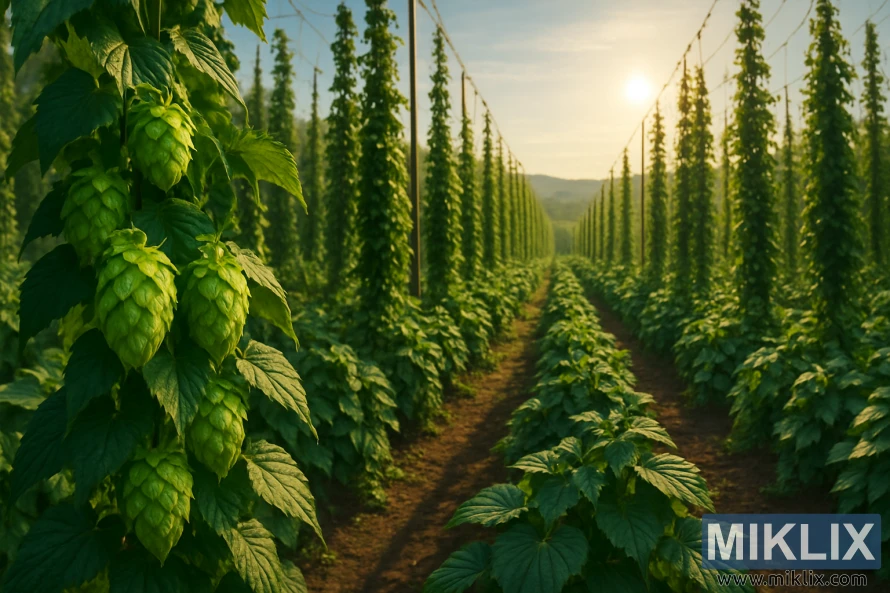Image: Cluster Hop Garden Scene
Published: August 14, 2025 at 6:47:23 AM UTC
Last updated: September 26, 2025 at 8:38:58 PM UTC
A golden-lit hop garden with Cluster hops on trellises, verdant rows of plants, and rolling hills, highlighting ideal growing conditions for this prized variety.
The image opens onto a sprawling hop garden basking under the warm embrace of a late afternoon sun, the kind of golden light that softens edges and saturates every leaf with radiance. Rising from the rich, earthen soil, rows of hop bines stretch upward in perfect formation, clinging to taut trellis wires that disappear into the hazy distance. The sheer symmetry of the plantation creates a sense of rhythm and harmony, each plant standing tall and vigorous, part of a collective abundance that stretches as far as the eye can see. This is a place where cultivation and nature meet in perfect accord, where the cycles of growth and harvest sustain both agriculture and artistry.
In the foreground, a cluster of hop cones dominates the view, their vibrant green bracts overlapping in intricate spirals that reveal both delicacy and strength. Dew clings to their surfaces in glittering beads, catching the angled sunlight like tiny prisms. These are the famed Cluster hops, a variety long cherished for its versatility and balance, and here they hang heavy with promise, their lupulin glands swelling inside, rich with the resins and essential oils that define their character. Their presence is tactile even through the image: one can almost feel the papery texture of the bracts and imagine the burst of aroma—earthy, floral, with hints of spice and fruit—that would arise if one were to crush them lightly in the palm.
Beyond the cones, the middle ground reveals a vast expanse of hop rows stretching toward the horizon. Each bine, thick with leaves, casts intricate shadows onto the fertile soil, where alternating bands of light and shade create a living tapestry of green and brown. The air seems alive with gentle motion; though unseen, the suggestion of a breeze animates the scene, giving the impression of swaying leaves and cones rustling softly against one another. It is a reminder that these plants, though cultivated with precision, are deeply bound to the elements of sun, wind, and soil.
In the distance, the plantation gives way to rolling hills that rise like gentle waves, their slopes softened by atmospheric haze. Above them, the sky is a luminous gradient of soft blue and gold, a vast dome that seems to cradle the garden in tranquility. The sun hovers just above the horizon, casting long, golden shafts of light that cut through the trellis lines, bathing the field in an ethereal glow. The interplay of light and shadow creates an atmosphere of peace, as though time itself has slowed to honor this fleeting moment of ripeness and abundance.
What emerges from the scene is more than just an agricultural snapshot. It is an idyllic portrait of the essential growing conditions that have sustained the Cluster hop variety for generations: fertile soil, open skies, careful trellising, and the patience of farmers who know that each cone carries within it the potential for transformation. From these fields will come the bitterness that balances malt sweetness, the aroma that rises from a freshly poured glass, the flavors that define a brewer’s vision.
The image conveys not only beauty but also continuity. Cluster hops, one of America’s oldest cultivated varieties, have been rooted in fields like these for well over a century, bridging the traditions of early brewing with the innovation of modern craft beer. To see them here, thriving in orderly rows under a forgiving sky, is to glimpse both the heritage and the future of brewing. Every detail—the cones glistening in the foreground, the endless lines of bines, the horizon touched by golden light—works together to remind the viewer that beer begins in places such as this, where nature and human care converge to nurture a crop that is as beautiful as it is essential.
The image is related to: Hops in Beer Brewing: California Cluster

